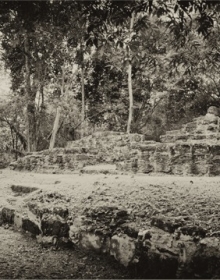The core of my El Pilar vision emerged from archaeological study of the development of the ancient Maya landscape. My research shows that clues to sustaining the complex habitats of today's Maya forest environment are embedded in Maya prehistory. Ancient Maya settlement and community patterns—as well as the forest context in which they are enveloped—are material evidence for the creation of sustainable economies in one of the planet's last frontiers: the tropics.
The ancient Maya landscape was a mosaic that was managed for millennia in an area today where the dominant plants are of economic value. Contemporary Maya farmers maintain forest gardens, based on their rich traditional knowledge of plant use creating the most diverse domestic system in the world. To understand the archaeological settlement patterns of El Pilar, I identified traditional farmers and began to inventory plants for food, medicine, spices, dyes, ornaments, construction, household products, toys, beverages, rituals, fodder, and more. The exercise prompted a local response, bringing a group together to educate their youth.
The goals of my evolving program are to demonstrate the critical relevance of basic research to advance conservation and development around the world today. Pioneering immigrants are moving into the tropics in record numbers; the population of the Petén of Guatemala has increased 10-fold, to more than 500,000, in the last 25 years. Unfamiliar with the region's resources and promoted by development strategies of monoculture suited to temperate zones, these agricultural practices are bankrupting the assets that gave rise to the ancient Maya civilization.
Testimony to the value of the Maya support system is to be found among the contemporary farmers born in the Maya forest as well as in the ancient settlement patterns of their ancestors. The bank of inherited knowledge is vanishing just as the El Pilar model seeks to gather in the wisdom of Maya forest and culture to applying agricultural lessons the Maya learned thousands of years ago. By recovering this fleeting knowledge, the Forest Garden program will demonstrate that creative conservation can pay practical and immediate dividends. And, importantly, this can be accomplished while tapping the wave of eco-tourism to improve village lives.
The results of my archeological research are germane to this quest. The steady advance of the agricultural frontier devastates the protective forest and the increased looting of ancient Maya monuments to serve the illegal antiquities market threatens Maya prehistory. There is an urgent need to break the cycle with something that is completely different. Lessons learned over the past century of archaeological endeavors demonstrate that the practice of exposing architecture puts the monuments at risk. The protective mantle of earth and forest canopy moderate temperatures and are natural preservatives. Once denuded, the ancient and porous limestone facades—just as the regenerative qualities of the fertile soil—are at the mercy of the sun's destructive heat, humidity's inevitable acid dissolution, and gravity's pernicious force. In the face of these bare facts, the temples are degrading to powder as the delicate artistry of the architecture transforms to dust.
At El Pilar, we have designed an original and convincing model for the monuments based on our "Archaeology Under the Canopy" program; one that opens the forest landscape to frame the spectacular scenes the ancient Maya enjoyed. We can never actually know what the monuments looked like in Maya times. So, we need to break away from standard presentations of ancient monuments and bring their unique qualities to the fore. The romantic view of archaeology is exploration and discovery, so why not create that experience? Every visitor can explore El Pilar for the first time and experience something that challenges the imagination.
The conservation of the forest was essential to the evolution of Maya civilization and today it is critical to the ecological balance of our world's environment. The forest canopy protects the ancient monuments as it provides a vital green mantle for maintaining our future. Taking advantage of this, the El Pilar Program's aim is to develop an integrated model of culture and nature—past and present. "Archaeology Under the Canopy" conserves environmental diversity and preserve the irreplaceable cultural heritage of both the ancient and contemporary populations in the region.

